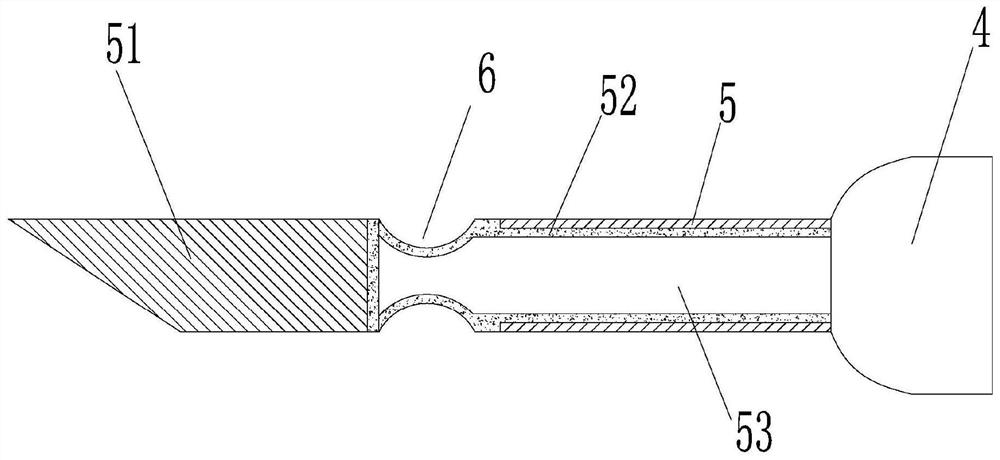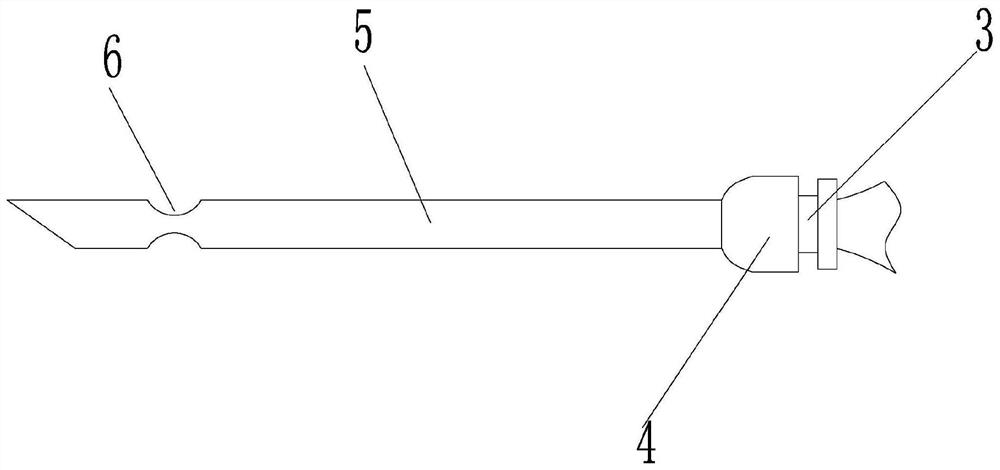A method for making animal specimens of hairless vertebrates and the syringe used
A vertebrate and syringe technology, applied in the field of animal specimen production, can solve the problems of high production cost, complex morphological structure, uneven response, etc., and achieve the effects of solving uneven filling, expanding the scope, and reducing the number of pinholes
- Summary
- Abstract
- Description
- Claims
- Application Information
AI Technical Summary
Problems solved by technology
Method used
Image
Examples
Embodiment 1
[0034] Depend on Figure 1-3 Given, the syringe of the present invention comprises a syringe 1, a piston core rod 2 and a needle 5, the piston end 2a of the piston core rod 2 extends into the inner cavity of the syringe 1 from the mouth of the rear end of the syringe 1, and the needle 5 is installed in the needle cylinder 1. The front end, the inner cavity of the syringe between the needle head 5 and the piston end of the piston core rod constitutes a negative pressure sliding stroke chamber 1a, and the piston core rod slides forward and backward along the length of the inner cavity of the syringe to form the length adjustment of the negative pressure sliding stroke chamber. structure, the needle 5 is a hollow structure with one end open and one end sealed, and its open end is connected with the negative pressure sliding stroke cavity 1a, so that the needle inner cavity 53 of the needle is connected with the negative pressure sliding stroke cavity 1a, and the outer wall of the ...
Embodiment 2
[0042] The making of the skinned specimen of embodiment 2 Chinese water snake
[0043] Animal material: Chinese water snake (about 5m in length)
[0044] Experimental steps:
[0045] 1. Soak the remains of Chinese water snakes that died naturally in absolute ethanol for 48 hours.
[0046] 2. Take out the remains of the Chinese water snake soaked in absolute ethanol, put the belly up, and place it flat on the dissection tray. Use dissecting scissors to make a longitudinal incision (3 cm) at the 2 / 3 of the abdomen of the Chinese water snake (that is, 1m away from the head). about). Use tweezers to peel off the skin and muscle at the incision until the muscle and skin at the incision are completely separated (without harming the skin of the Chinese water snake).
[0047] 3. Use a scalpel to cut off the snake body at the incision, and use tweezers to peel it upwards from the incision to the head of the Chinese water snake, keep the snake head, and cut off the snake body (includ...
Embodiment 3
[0055] The making of the skinned specimen of embodiment 3 Brazilian tortoise
[0056] Animal material: Brazilian tortoise (about 15cm in length)
[0057] Experimental steps:
[0058] 1. Process the remains of the Brazilian tortoise that died naturally: peel off the abdominal bone plate of the Brazilian tortoise from one side of the abdominal bone plate to completely separate the muscles, skin and bones from the abdominal bone plate; use iron wire from one side Use pliers to open the shell of the Brazilian tortoise. When opening the shell, be sure to ensure that the shell is complete and the edges of the cut are neat.
[0059] 2. Remove the viscera of the Brazilian tortoise after opening the shell, and use planing scissors and ophthalmic forceps to remove the muscles and bones of the Brazilian tortoise's limbs, head and tail (removal of the forelimbs to the carpal bones, hind limbs to the tarsal bones, head Remove the entire part to the skull, remove the eyeballs of the Brazi...
PUM
| Property | Measurement | Unit |
|---|---|---|
| length | aaaaa | aaaaa |
| diameter | aaaaa | aaaaa |
| diameter | aaaaa | aaaaa |
Abstract
Description
Claims
Application Information
 Login to View More
Login to View More - R&D
- Intellectual Property
- Life Sciences
- Materials
- Tech Scout
- Unparalleled Data Quality
- Higher Quality Content
- 60% Fewer Hallucinations
Browse by: Latest US Patents, China's latest patents, Technical Efficacy Thesaurus, Application Domain, Technology Topic, Popular Technical Reports.
© 2025 PatSnap. All rights reserved.Legal|Privacy policy|Modern Slavery Act Transparency Statement|Sitemap|About US| Contact US: help@patsnap.com



